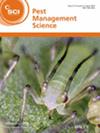Enantioselective metabolism of fenpropathrin enantiomers by carboxyl/choline esterase 6 in Tetranychus cinnabarinus
Abstract
BACKGROUND
Tetranychus cinnabarinus is a polyphagous pest mite commonly found in agriculture. As an excellent acaricide, fenpropathrin (FEN) is frequently used to control T. cinnabarinus in agriculture. However, commercial FEN is a racemate with two enantiomers, R-FEN and S-FEN. Considering that investigations on the metabolism of FEN by T. cinnabarinus are based on racemate FEN, it is important to investigate the enantioselective metabolism of FEN in T. cinnabarinus.
RESULTS
S-FEN was more toxic to T. cinnabarinus than R-FEN by more than 68.8-fold. Moreover, the synergist bioassay revealed that carboxylesterase and cytochrome P450 were the primary enzymes engaged in the detoxification of FEN in T. cinnabarinus, with carboxylesterase playing a leading role. Seven genes were substantially different after the induction of S-FEN and R-FEN. TcCCE06 was screened and selected as a key gene that related to FEN metabolism in T. cinnabarinus. The metabolic results showed that the recombinant TcCCE06 effectively metabolized 32.1% of the R-FEN and 13.8% of the S-FEN within 4 h of incubation. Moreover, R-FEN was demonstrated to have a higher affinity for the TcCCE06 protein than S-FEN based on molecular docking.
CONCLUSION
Our results indicated that TcCCE06 mediates the enantioselective metabolism of FEN in T. cinnabarinus. Our findings will contribute to a more comprehensive understanding of the mechanisms underlying the differential toxicity of the FEN enantiomers against T. cinnabarinus. Furthermore, they also provide a new perspective for the development of enantiomer-enriched acaricides with higher activity and lower pesticide dosage and pollution risks. © 2023 Society of Chemical Industry.

 求助内容:
求助内容: 应助结果提醒方式:
应助结果提醒方式:


